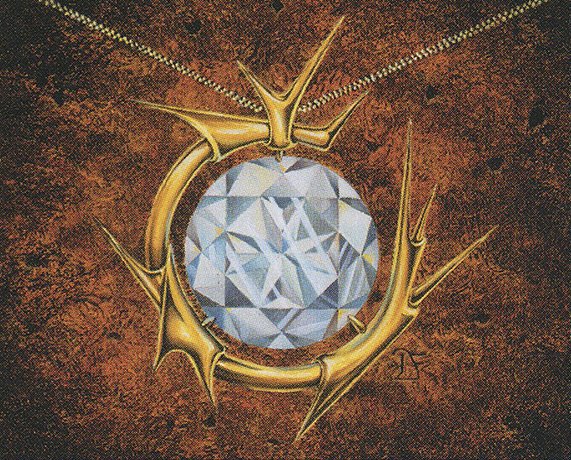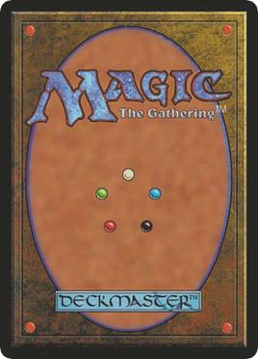 Art by Dan Frazier
Art by Dan FrazierWelcome! My cube is a 450 Un-powered cube. For those of you who are new to it, this aims at shedding light on what archetypes can be drafted and a general over view of what my cube has set out to accomplish.
Mono-White, is a deck full of underpowered cards that actually manages to win a ton. When it’s open, which it usually is, this deck can be very good.
This deck plays out pretty straightforwardly, and one of its advantages is that most of its cards are interchangeable. As long as you have some mana disruption, what you pressure the opponent with doesn’t matter quite as much.
When to get in:
- Force it. I know multiple people who’ve done quite well doing just that because the deck is underdrafted. Assuming it’s open from pack 1, it's not the worst idea.
- Pick up an early Armageddon and Thalia, Guardian of Thraben. If you start with disruption, you’ll do well.
- Play cheap white creatures and back them up with mana denial and equipment.
This deck is also quite good, and also tends to be underdrafted.
The deck is pretty single-minded. Attack them early and blow up a land or an artifact, and you usually have enough time to burn them out. It is very important to note that this deck gets much worse if it’s 2 colors, so I only splash if I have 3-4 fixers, and only 1-3 cards of the splash color.
When to get in:
- Like WW, you can just force this deck. It’s a great deck when nobody else is drafting it.
- See an early Sulfuric Vortex, Goblin Guide, or Shrine of Burning Rage. Anyone who passes these cards isn’t drafting mono-red, so if you see a 5th pick Shrine, you’re in.
- Note red cards, and see them wheel. Like Mono White, if the cards are wheeling, you are in good shape, and this is a very likely scenario.
This deck is heavy black, and in the case of the best versions, even mono-black (though blue-black and black-red are are more common than mono-black). It’s capable of some of the fastest draws in the format, and does a lot of sweet things that can overlap with the Sneak Attack deck.
The core of the deck is black, and blue and red offer various discard possibilities to help with that. Red also offers Sneak Attack and Through the Breach, which are a natural fit in a deck with big monsters. This deck doesn’t need artifact ramp as much as other decks, so move that down if you are going this direction. Besides Entomb, Griselbrand, this deck doesn’t have a lot of cards I like taking very early. I won’t usually start with a pick-2 Reanimate, and I’m not taking Oona's Prowler or Woodfall Primus in my first few picks. But if you see a few reanimator cards in your first few picks, take generic good cards and note if they wheel. If they do, this deck is open, and can be quite good when it is.
When to get in:
- See an early Entomb or Griselbrand//Archon of Cruelty.
- See mid-pack reanimation spells or discard outlets, grab a fatty or 2.
A great deck when it’s open & most times it is. This is also one of the easier decks to get decent with, because, well, it’s mono-green. Take the green cards, and you will do a decent job.
Mono-Green isn’t as mono-colored as the name suggests, because green does allow you to splash easily. The biggest key to splashing is getting the green/X dual land of whatever color you want, because the deck does want 14+ Forests. Tropical Island is a high pick as a result, because blue is the most common splash color.......
Opposition is a special case. It’s mostly a subset of mono-green (though there is a blue-white Opposition tempo deck out there), and it’s one of the best cards for mono-green. If you get an early Opposition, the main changes you want to make to your pick order are that Tropical Island and mana dorks that tap for blue become critical (alongside fetches that get Trop), and blue cards like Remand, Mana Leak, Fact or Fiction, and Riftwing Cloudskate become viable picks. You also want to lean toward a creature-heavy deck, and Deep Forest Hermit becomes awesome instead of just good.
When to get in:
- See an early Rofellos, Gaea's Cradle, Opposition, Natural Order, or Craterhoof Behemoth.
- See a 4th-6th pick Green Sun’s Zenith or Oracle of Mul Daya.
- Wheel green mana dorks or see them mid-pack.
This is a control deck at it's core. You want to try and control the the board state and really use your life total to your advantage; because when things come together, you should be able to easily get there. There are "3" main win cons here and they all really can intertwine.
This deck is generally core green and red, but very commonly plays all 5 colors. Drafting lands here is obviously key here, and when you see key pieces of your puzzle, grab them. Crop Rotation/Knight of the Reliquary shine in here.
When to get in:
- Fetches are this decks best friend. Fixing your colors and giving you 2 triggers on your Field of the Dead.
- Vampire Hexmage & Thespian's Stage are pretty essential to your Dark Depths game plan. Don't miss them.
- This deck can easily win by Strip Mine/Wasteland locking your opponent out of their lands. Wrenn and Six is basically your best card here. And if you haven't T1 played land, Mox Diamond pitching a land, played Wrenn and Six getting back that land, have you really lived?
This archetype turns downsides into upsides by pairing sacrifice "enablers" (cards that let you sacrifice creatures) with sacrifice "payoffs" (cards that benefit you when creatures die) and sacrifice "fodder" (creatures that you don't mind losing, either because they come back from the dead or are dinky tokens). So Enablers + Fodder + Payoffs = Profit. Usually your payoffs are some combination of direct damage, life-drain effects, or card draw.
Look for recursive threats early in the draft. These staples are crucial to get any Aristocrat deck off the grounds. Once you have a skeleton of small threats you can start seeking out the fun stuff that will reward you for those creatures dying. I like to start out with versatile picks that could go into a wide number of decks, like Ophiomancer, Daretti, Ingenious Iconoclast, Gideon, Ally of Zendikar or Lingering Souls. These cards can all do well in an Aristocrat deck, but can also develop into really any deck that runs those colors.
When to get in:
- Grab cheap self recursive creatures early
- Pair them with a blood artist type effect.
- Grab any other pay-offs for sacking creatures.
A deck we've all seen before, spells-matters looks to play a high density of spells and a couple payoff cards that can get value out of those spells. Murmuring Mystic is one the best cards for the archetype. It doubles as a payoff card and a really effective blocker against aggro decks. Usually you are in Jeskai colors, but black can also be an option.
This deck plays out a lot like your typical tempo deck. Gaining advantages with 2 for 1 trades while slowly grinding your opponent out. This is the deck I most gravitate to, I enjoy the way the cards play off each other.
When to get in:
- Take your cantrips (spell that replaces itself with a draw) early, they allow all of your other cards to work as intended.
- Snag 2-3 of the token producers that play off the spells you cast.
- Build a control shell, and just 2 for 1 your opponents threats.
The Sneak Attack deck is the most reliable combo deck in the Cube. It’s a two-card combo, and Sneak is fast, hard to interact with, and combines with a ton of other cards, so the second part of the combo isn’t even very specific.
This deck is usually Grixis, mainly blue-red with a light black splash. It doesn’t mind having some acceleration, but it’s not nearly as critical as in the big mana deck. Part of the beauty of this deck is that the whole Sneak package is very small—the addition of Sneak Attack, Show and Tell, and 2 Eldrazi can make any blue deck into one with a busted endgame. It’s the perfect finisher for decks with good card draw and disruption.
When to get in:
- See an early Sneak Attack or Show and Tell, or a 5th-7th pick Through the Breach.
- See a 3rd-4th pick Emrakul or Archon of Cruelty.
- Take a late pick other Eldrazi and see Sneak or Breach in packs 2/3.
This deck uses the combo of Kiki or Twin plus one of Exarch, Pestermite, Combat Celebrant, Zealous Conscripts, or Restoration Angel (note that Twin plus Angel is the only combo that doesn’t work). It is Izzet with a white splash for Restoration Angel or Recruiter of the Guard, and usually plays like a control deck with a combo finish
Like the Sneak deck, this deck can be a finishing package for any blue control deck, and due to that it's a desirable place to be. It even works nicely with Sneak, as Sneak Attack makes the combo very cheap to assemble.
When to get in:
- See an early Kiki or Twin.
- See a mid-pack creature (Resto, Exarch, etc.)
- Have a good amount of value creatures, and see Kiki/Twin in pack 2/3
This archetype has a surprising number of colors it can fit into. White and blue work well, obviously. You have Day of Judgment and Wrath of God to reset the board. And blue has great counters in Force of Negation, Mystic Confluence, and some other classics.
Black and red have some very good removal that can be coupled with a control strategy, including Thoughtseize. Coercive Portal is great in these types of slow-paced strategies.
When to get in:
- Take permission and cantrips highly. Planeswalkers also shine here.
- Draft your lands. Then draft some more. Can't stress it enough.
- Creatures with flash, like Vendilion Clique are great because they allow you to leave your mana open for use on opponents turn.
- This deck only needs 1 or 2 threats, then just sit back and protect them.
I hope this was informational to my newer drafters. Cube is a huge passion of mine, and without you all here to draft it, I can't enjoy it as much. I really do enjoy sharing the experience and joy I get from these cards with the rest of you. I encourage you all to try cube, even just once, before you blow it off. I think you will get hooked. I know I have. Thanks.
Matt
I copied and pasted some portions of this from different articles on the net, some of these words are not my own

